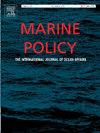Behavioural response thresholds for the assessment of noise impact on Antarctic marine mammal species
IF 3.5
2区 社会学
Q2 ENVIRONMENTAL STUDIES
引用次数: 0
Abstract
Increasing levels of anthropogenic noise in our oceans is concerning, especially in Antarctic waters where marine mammals are more naïve to sound sources, compared to those residing in industrialised ocean basins. Marine mammals are vulnerable to anthropogenic noise, due to their dependence on underwater sounds for their survival. The Protocol on Environmental Protection to the Antarctic Treaty stipulates that anthropogenic activities in Antarctic waters must be assessed in advance, for the comprehensive protection of the natural environment and its dependent ecosystems. There are few quantitative studies on the behavioural responses of Antarctic marine mammals. Furthermore, the absence of agreed upon thresholds for marine mammal behavioural responses has created difficulties in conducting impact assessments in a standardised manner. In instances where knowledge gaps persist amidst high priority management issues, the expert elicitation approach can be implemented to utilise an expert’s qualitative knowledge. This study elicited probability distributions of noise levels which would lead to a significant behavioural response, when received under specific acoustic exposure scenarios. The sound sources examined include vessels, research seismic survey activities and hydroacoustic research equipment. The expert judgements exhibited substantial variability amongst thresholds due to limited data on marine mammals in Antarctic waters, with low frequency cetaceans eliciting a threshold of Lp = 137 dB re 1 µPa for vessel noise, compared to Lp = 145 dB re 1 µPa for hydroacoustic research equipment. These thresholds are an initial tool in the assessment process, whilst guiding priorities for future research to quantitatively address this pressing management issue.
评估噪音对南极海洋哺乳动物影响的行为反应阈值
海洋中人为噪音的增加令人担忧,特别是在南极水域,与生活在工业化海洋盆地的海洋哺乳动物相比,那里的海洋哺乳动物对声源更加naïve依赖。海洋哺乳动物很容易受到人为噪音的影响,因为它们依赖水下的声音来生存。《南极条约环境保护议定书》规定,为了全面保护自然环境及其依赖的生态系统,必须事先对南极水域的人为活动进行评估。关于南极海洋哺乳动物行为反应的定量研究很少。此外,由于没有商定海洋哺乳动物行为反应的阈值,因此难以以标准化方式进行影响评估。在知识差距在高优先级管理问题中持续存在的情况下,可以实施专家启发方法来利用专家的定性知识。这项研究引出了在特定的声音暴露情景下接收到的噪音水平的概率分布,这些噪音水平会导致显著的行为反应。检查的声源包括船只、研究性地震调查活动和水声研究设备。由于南极水域海洋哺乳动物数据有限,专家判断的阈值存在很大差异,低频鲸类对船舶噪声的阈值为Lp = 137 dB re 1µPa,而水声研究设备的阈值为Lp = 145 dB re 1µPa。这些阈值是评估过程中的初始工具,同时指导未来研究的优先事项,以定量地解决这一紧迫的管理问题。
本文章由计算机程序翻译,如有差异,请以英文原文为准。
求助全文
约1分钟内获得全文
求助全文
来源期刊

Marine Policy
Multiple-
CiteScore
7.60
自引率
13.20%
发文量
428
期刊介绍:
Marine Policy is the leading journal of ocean policy studies. It offers researchers, analysts and policy makers a unique combination of analyses in the principal social science disciplines relevant to the formulation of marine policy. Major articles are contributed by specialists in marine affairs, including marine economists and marine resource managers, political scientists, marine scientists, international lawyers, geographers and anthropologists. Drawing on their expertise and research, the journal covers: international, regional and national marine policies; institutional arrangements for the management and regulation of marine activities, including fisheries and shipping; conflict resolution; marine pollution and environment; conservation and use of marine resources. Regular features of Marine Policy include research reports, conference reports and reports on current developments to keep readers up-to-date with the latest developments and research in ocean affairs.
 求助内容:
求助内容: 应助结果提醒方式:
应助结果提醒方式:


